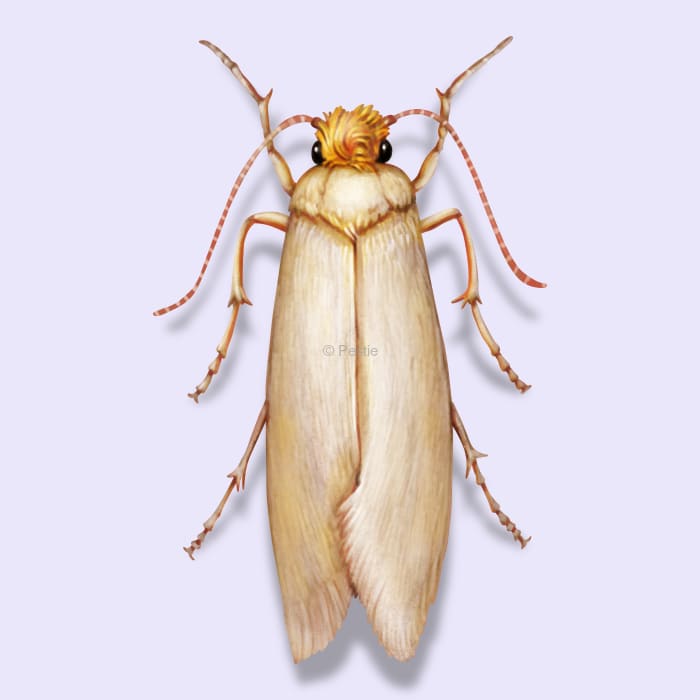How to identify and get rid of clothes moths

How to save your sweaters from getting chewed on
Have you ever had a favorite shirt, sweater, or piece of clothing that looked like somebody shot it with a shotgun? You were probably the victim of the clothes moth, a pesky but shy insect that's out to turn your closet into its own personal buffet. These little bugs might not bite you, but they sure have a taste for your best threads.
Clothes moths are tiny moths that like to infiltrate your closets, lay their eggs, and then hide in the shadows. Both male and female clothes moths hate light, and that's one reason why you may not know you have an infestation until it's too late.
It's the clothes moth caterpillars that are doing all the damage. They prefer to eat natural fibers like wool but will also go after your carpet, drapes, and furs. If the fabrics are dirty, especially with human sweat, all the better!
How to identify clothes moths
Clothes moths are two different moth species that look very similar in appearance. They both have narrow wings that end in hairy fringes. Their color is a light brownish-yellow color. Sometimes, in the light, they look a bit golden. They have a fuzzy golden-brown head with black eyes.
The adults are not very good flyers, and they tend to avoid light. That's why they are more common in closets and storage areas, where they can lay their eggs on suitable fabrics and materials.
The caterpillars are usually tiny when they first hatch and remain creamy white. The webbing clothes moth forms a silken tube or patch where they shelter and move along the surface, munching away on your clothes. Casemaking clothes moth creates a tube-like case that it carries wherever it goes. They often wrap silk and the materials they are on into a case.
How big are clothes moths?
Clothes moths have a wingspan between 1/3 inch to 2/3 inch long. The caterpillars only grow to be ½ inch long.
What other pests look like a clothes moth?
The two species of clothes moth look like each other, but they both can get mixed up with Indian meal moths, brown clothes moths, or whiteflies. Indian meal moths are darker in color and will fly near lights.
Additionally, damage done to clothes, fabrics, and carpets can look similar to the feeding by carpet beetles. You'll want to either look for the hairy cast skins of carpet beetles or the silk left behind by clothes moths.
Where do clothes moths live?
Clothes moths can be found all over the US and Europe. They like to hide in closets, drawers, and storage areas where natural fibered clothes are kept.
How to get rid of clothes moths
A lot of times, prevention can help keep clothes moths from nibbling on your favorite outfits. One of the best things to do is to keep your home clean. That means frequently vacuuming, sweeping floors, and cleaning up pet hair that might accumulate near baseboards or under appliances. Vacuuming your home is an easy way to reduce the chances that clothes moths become a real issue.
If you discover clothes moths on your fabrics, washing them in hot water or dry cleaning them is the best way to eliminate any caterpillars or eggs. Newly hatched caterpillars are nearly microscopic and can be hard to miss.
To keep clothes moths away, seal up expensive or valued garments in an airtight container with mothballs. But, make sure to read the instructions on the product first and cautiously follow them, as the mothball vapors can be harmful.
Treat clothes moths with Pestie
If you're still having trouble keeping clothes moths away, the best option is to use a pro-grade, effective pest control solution like Pestie.
Pestie is a do-it-yourself pest control solution that's specially designed to keep clothes moths and other pests away from your home.
With Pestie, you can rest easy knowing that your living space is protected and free of creepy crawlies. And the best part? It's designed for people, pets, and the planet, so you can say goodbye to harsh chemicals and hello to peace of mind!
- Save hundreds compared to traditional annual pest plans
- People, pet, and planet-friendly
- Pro-grade customized formulas
Quick facts
- Scientific name
Tineola Bisselliella
- Other common names
Common Clothes Moths, Webbing Clothes Moths, Clothing Moths
- Colors
Natural fibers like wool, silk, fur, pet hair, carpet
- Life span
2-3 months
- Diet
Golden-buff
How dangerous are Clothes Moths?
Low danger risk
Clothes moths aren't dangerous to humans or pets, but your clothes are in danger!
The casemaking clothes moth was one of the first moths to be scientifically described back in the 18th century.








